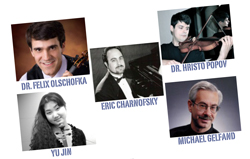by Daniel Hathaway

Popov, who is artistic director of the Chagrin Valley Chamber Music Series, has chosen the Shostakovich, along with chamber works by Mozart and Dvořák, for the season finale of the series on Sunday, April 6 at 3:00 pm in Valley Lutheran Church in Chagrin Falls. The concert is free.
Shostakovich, who had a complicated relationship with the Stalinist government of the USSR, falling in and out of official favor on a regular basis, wrote his only chamber work for piano and string quartet in 1940, a piece that has been described as both rigorous and accessible. It was enthusiastically received at its first performance by Shostakovich and the Beethoven Quartet, who encored both the scherzo and finale.
The composer joked that he had written himself into the 40-minute work so it couldn’t be toured with another pianist — and indeed it allowed him to travel with both the Beethoven and Glazunov quartets. “It’s a challenge to make all the changes in mood,” Popov said, “and also a challenge to rehearse. You get one section right emotionally, then you have to move on to the next. It’s also technically challenging. While it’s not the most avant-garde piece, there are many unusual things about its structure — irregular rhythms and phrases and unpredictable twists. Just like his life at the time.”
For the quintet, Popov will be joined by German-born violinist Felix Olschofka, violist Yu Jin, cellist Michael Gelfand and pianist Eric Charnofsky. Earlier in the program, Olschofka and Charnofsky will play Mozart’s A-Major Sonata, K. 305, a two-movement work written in Mannheim in 1778 while the 22-year old composer and his family were enroute to Paris.
To complete the afternoon, Popov, Olschofka and Jin will perform Dvořák’s Terzetto, intended as a piece of house music for himself as violist, his colleague, violinist Jan Pelikan, and Pelikan’s student Josef Kruis, a hapless fiddler whose name has gone down in history because his part was too difficult for him. Dvořák charmingly simplified the second violin line, then later recast the work for violin and piano. This Sunday’s audience, however, will hear the original version from 1887, a surprisingly deep, complex and virtuosic work considering its recreational nature. Olschofka, who teaches at North Texas State University in Dallas and met Popov while playing chamber music in New York, will have absolutely no problem with Dvořák’s second violin part.
Published on ClevelandClassical.com April 1, 2014
Click here for a printable version of this article.



